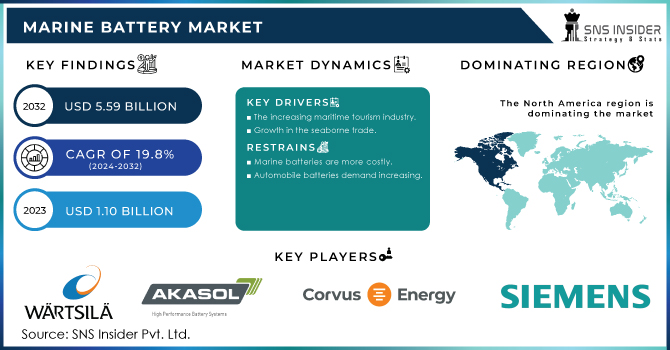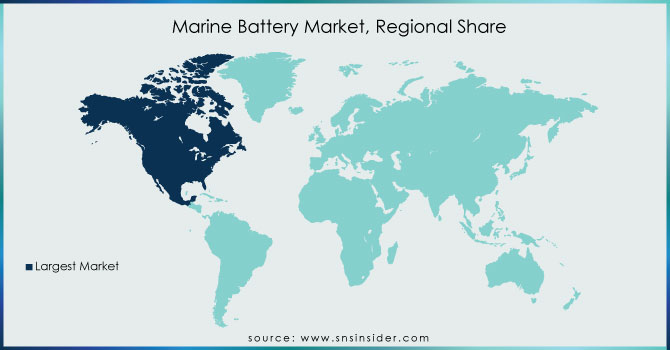Marine Battery Market Report Scope & Overview:

To get more information on Marine Battery Market - Request Free Sample Report
The Marine Battery Market size was recorded at USD 1.10 Billion in 2023 and is projected to reach USD 5.59 Billion by 2032, growing at a CAGR of 19.8% during the forecast period 2024-2032.
The marine battery acts as the vessel's primary or auxiliary power source, utilizing chemical energy to power various applications such as start–stop, illumination, a windlass, depth finders, and fish locators. Marine batteries are made of higher strength and feature heavier plates. These batteries are particularly built for use on ships or boats to withstand the vibration and pounding that can occur on any boat.
MARKET DYNAMICS
KEY DRIVERS
-
The increasing maritime tourism industry
-
Growth in the seaborne trade
-
Implementation of the I.M.O. sulfur 2020 regulation.
RESTRAINTS
-
Marine batteries are more costly.
-
Automobile batteries demand increasing
OPPORTUNITIES
-
High utilization of renewable energy for battery charging.
-
High use of hybrid propulsion technology.
CHALLENGES
-
Lack of Technical knowledge.
THE IMPACT OF COVID-19
Most regional markets were badly affected by the Covid-19 pandemic in the first half of 2020. The worldwide market came to a standstill during the lockdown era, which hampered the expansion of the marine battery industry. Transportation and productivity have slowed as movement has been constrained. This resulted in investor losses.
According to the marine battery market outlook, the unlock phase in the second half of 2022 has given the global market a boost. As a result, the global market is increasing market participants' confidence and adopting safety measures in order to produce significant Marine Battery Market revenue throughout the research period.
MARKET ESTIMATIONS
By Propulsion Type
The global marine battery market has been segregated into Hybrid, Fully Electric, and Conventional.
By Ship Type
Based on ship type, the global marine battery market has been segregated into defense and commercial segments.
The commercial segment led the global market in 2022, accounting for a larger proportion of the marine battery market.
During the review period, the defense segment is projected to contribute a higher growth rate.
By Application
Deep Cycle Service, Marine Starting Service, and Dual Purpose Service are the three segments of the worldwide marine battery market.
During the assessment period, the marine starting service segment is expected to have the highest CAGR.
These batteries are developed to provide hundred of amps of power to the starting motor in a matter of seconds.
KEY MARKET SEGMENTATTION
By Application
-
Commercial
-
Defense
-
Unmanned
By Battery Design
-
Solid-State Batteries
By Battery Function
-
Starting Batteries
-
Deep-Cycle Batteries
-
Dual-Purpose Batteries
By Battery Type
-
Nickel Cadmium
-
Sodium Type
-
Lead-Acid Battery
-
Flooded
-
Gel
-
Fuel Cell
By Propulsion Type
-
Introduction
-
Fully Electric
-
Hybrid
-
Conventional
By Sales Channel
-
Introduction
-
OEM
-
Aftermarket
REGIONAL ANALYSIS
The North American market is fueling the growth of the maritime battery market due to the growing demand for electric-powered naval vessels in the Navy in the United States. In addition, the North American regional market is boosting market growth thanks to major marine battery manufacturers such as East Penn Manufacturing Co., EnerSys, and Exide Technologies. In 2019, the Asia-Pacific regional market was calculated as the market share for the largest batteries in the ocean and it was also predicted to account for the highest CAGR at the time of the study. The region is gaining more success in the global market due to the growing demand for advanced and new naval vessels and the growing cost of protection in China and India. In addition, the Latin American market is driving the growth of the marine battery market due to the increased cost of Brazil in purchasing advanced and new marine vessels. In addition, the Middle East and Africa are booming with market growth due to rising defense costs in Israel, the U.A.E., And Saudi Arabia.

Need any customization research on Marine Battery Market - Enquiry Now
REGIONAL COVERAGE
North America
-
USA
-
Canada
-
Mexico
Europe
-
Germany
-
UK
-
France
-
Italy
-
Spain
-
The Netherlands
-
Rest of Europe
Asia-Pacific
-
Japan
-
South Korea
-
China
-
India
-
Australia
-
Rest of Asia-Pacific
The Middle East & Africa
-
Israel
-
UAE
-
South Africa
-
Rest of Middle East & Africa
Latin America
-
Brazil
-
Argentina
-
Rest of Latin America
KEY PLAYERS
The Key Players are Wartsila, Akasol AG, Corvus Energy, Enchandia AB, Saft Total, Siemens, Leclanché SA & Other Players.
| Report Attributes | Details |
|---|---|
| Market Size in 2023 | US$ 1.10 Billion |
| Market Size by 2032 | US$ 5.59 Billion |
| CAGR | CAGR of 19.8 % From 2024 to 2032 |
| Base Year | 2022 |
| Forecast Period | 2024-2032 |
| Historical Data | 2020-2022 |
| Report Scope & Coverage | Market Size, Segments Analysis, Competitive Landscape, Regional Analysis, DROC & SWOT Analysis, Forecast Outlook |
| Key Segments | • By Battery Type (Lithium, Nickel Cadmium, Fuel Cell, Lead-acid) • By Propulsion Type (Fully Electric, Hybrid, Conventional) • By Sales Channel (OEM, Aftermarket) • By Battery Design • By Application |
| Regional Analysis/Coverage | North America (USA, Canada, Mexico), Europe (Germany, UK, France, Italy, Spain, Netherlands, Rest of Europe), Asia-Pacific (Japan, South Korea, China, India, Australia, Rest of Asia-Pacific), The Middle East & Africa (Israel, UAE, South Africa, Rest of Middle East & Africa), Latin America (Brazil, Argentina, Rest of Latin America) |
| Company Profiles | Wartsila, Akasol AG, Corvus Energy, Enchandia AB, Saft Total, Siemens, Leclanché SA |
| DRIVERS | • The increasing maritime tourism industry • Growth in the seaborne trade • Implementation of the I.M.O. sulfur 2020 regulation. |
| RESTRAINTS | • Marine batteries are more costly. • Automobile batteries demand increasing |

